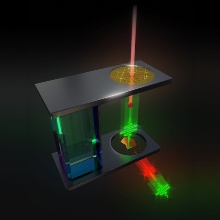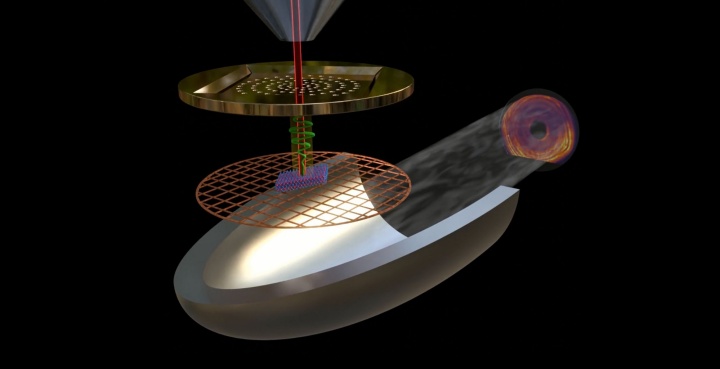A slow-motion movie on sports television channels shows processes in hundredths of a second. By contrast, processes on the nanoscale take place in the so-called femtosecond range: For example, an electron needs only billionths of a second to orbit a hydrogen atom. Physicists around the world are using special instruments to capture such ultrafast nano-processes in films.
Researchers at Kiel University (CAU) and at the University of Stuttgart have developed a new method for such films that is based on a different physical concept and thus allows further and more precise options for investigation. To do this, they combined an electron microscope with nanostructured metallic thin films that generate very short light pulses. In a first experiment, they were thus able to document the coherent interactions of light and electrons in a semiconductor on film. Their results are February, 23, 2023 in the renowned scientific journal Nature Physics.
New method is simpler and more cost-effective
Until now, movies showing ultrafast nano-processes have typically been produced using high-power lasers combined with electron microscopes. But only a few research groups can afford the large and complex setups. "Our concept does not require expensive and complicated lasers and can be easily replicated," says Nahid Talebi, Professor of Experimental Physics at the CAU.
Electron microscopes bundle electrons into a beam, accelerate it and direct it at a material sample. How the electrons pass through the sample or are reflected allows conclusions about the properties of the materials and the processes inside. “Electron microscopes have a significantly better spatial resolution than optical microscopes and make investigations in the nanometer range possible in the first place," says Talebi. The special components she has developed make it relatively easy to improve also the temporal resolution of electron microscopes and convert them to their ultrafast versions. By this nanoscale processes can now also be captured in ultrafast films on the femtosecond time scale without lasers.
University of Stuttgart develops "Nanosieve" to deliver the short light pulses required
A key component of Talebi's concept is a special "nanosieve" that can be used in an electron microscope and functions like a light source. When an electron beam hits this, the hole pattern generates targeted, short light pulses that can be used to make fast films. To create the special sieve, researchers drilled tiny holes of 25 to 200 nanometers into a thin gold foil. The "nanosieves" were produced in close collaboration with Dr. Mario Hentschel from the research group led by Prof. Harald Giessen, 4th Physics Institute, which is a part of the profile area Quantum Technology and the Stuttgart Research Center of Photonic Engineering (SCoPE) at the University of Stuttgart. Talebi was already exploring her concept for femtosecond films with an electron microscope without needing a laser while she was still a research associate at the Max Planck Institute for Solid State Research in Stuttgart and a postdoctoral fellow at the 4th Institute of Physics. The concept was also awarded an ERC Starting Grant of EUR 1.5 million from the European Research Council of the EU. The 4th Institute of Physics with its excellent infrastructure in the field of nanotechnology is one of the world's leading research groups in the field of ultrafast nano-optics and plasmonics and has enjoyed many years of successful collaboration with the MPI for Solid State Research.
Interactions between electrons and photons documented in films
In the experiment described in the current publication, the short light pulses from the sieve-like nanostructures hit the semiconductor sample at the speed of light. Here they excite excitons, so-called quasiparticles. These are electrons that have detached themselves from an atom and are still coupled to the hole they created ("electron-hole pairs"). "If a short time later the slower electron beam also hits the semiconductor sample, we can see from the reaction of the electrons how the excitons have behaved in the meantime," explains Talebi. The resulting cathodoluminescence signals from the superposition of the electron beam and the light pulses show a coherent interaction between electrons and photons.
To be able to capture these processes in a film, the researchers also integrated a piezoelectric crystal into the microscope setup. This allows them to precisely change the spatial distance between the light source and the sample, and by this also the temporal distance between the incident light pulses and the electrons. In this way, images can be taken at different stages of the process and assembled into a film.
(c) Kiel University (CAU)
Publication:
Taleb, M. Hentschel, K. Rossnagel, H. Giessen, N. Talebi, „Phase-locked photon-electron interaction without a laser”, Nature Physics (2023). DOI: 10.1038/s41567-023-01954-3
| Contact | Expert Contact at the University of Stuttgart: Prof. Harald Giessen, Mario Hentschel, 4th Physics Institute, Tel. +49 711 685 65110 |
|---|



